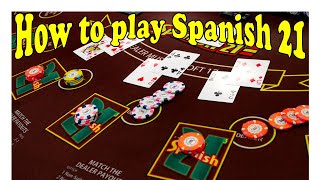Blackjack Tips Information & Video Source:
Spanish 21 is played on a blackjack table with a custom layout and uses the following rules:
The game is played with six or eight decks dealt from a shoe, or from a continuous shuffling machine (CSM). Spanish 21 is played with 48-card Spanish decks, although standard French suited 52-card decks are used with the 4 ten-spot cards removed. All cards have the same values as in blackjack.
The dealer gets a hole card.
Like traditional blackjack, the dealer hits on 16 and stands on 17. In some venues, the dealer hits on a soft 17 (abbreviated as H17), though most venues have the dealer stand on soft 17 (S17). Hitting soft 17 (H17) negatively impacts the player; that rule increased the house edge by 0.40%.
Blackjack (a natural total of 21 on the first two cards) always wins, and is always paid 3:2 regardless of whether or not the dealer has a blackjack.
Insurance is paid 2:1, just like in blackjack, despite the fact that there are four fewer ten-valued cards per deck. As 3 cards in 12 are worth ten, the chance of the dealer getting a blackjack when showing an Ace is only 25%. Therefore, for insurance to be an even bet, it would have to pay 3:1, not 2:1. The house edge on the insurance is 24.7%, one of the worst of any wager in a casino.
Hitting, standing, and splitting all follow similar rules to blackjack. Doubling after splitting (DAS) is always permitted, and, in most venues, players are allowed to draw as many cards as they wish after splitting aces, or may double down after receiving second or subsequent cards.
Players can split to a maximum of four hands, even on aces.
Spanish 21
Introduction
Spanish 21 is a variation of blackjack, that in some cases is the best bet in the casino. In locations where the dealer stands on a soft 17, or redoubling is allowed, Spanish 21 may be a better bet than blackjack, depending on the specific blackjack rules. If you are looking for a change of pace from traditional blackjack but insist on a game with a low house edge, then you may find new excitement in Spanish 21.
In Australia and Malaysia, Spanish 21 is called Pontoon. There are some rule changes in Australia, which merit a separate page. For all the details please visit my page on Australian Pontoon. To make matters more confusing, there is another similar game, but different enough to warrant a separate page, called Player’s Edge 21.
Following is a list of known aliases of the game:
Betsoft, a major provider of software for Internet casinos, offers Spanish 21 under the name Pirate 21.
The Casino Bregenz in Austria changes the name to Blackjack Exchange.
The Rules
Spanish 21 uses six or eight Spanish decks, each deck consisting of 48 cards — the regular 52 cards less the four tens. Any card counter can tell you that removing any 10-point card from the cards moves the odds in favor of the dealer. To make up for this, Spanish 21 gives the player a host of bonuses and favorable rules. There are lots of Spanish 21 games all over the country, so rules will vary somewhat from place to place, but the usual rules in the player’s favor are:
Late surrender allowed.
Double after split allowed.
Re-splitting aces allowed.
A player 21 always wins.
Player blackjack beats dealer blackjack.
Player may double on any number of cards.
Player may usually hit and double down after splitting aces.
Player may surrender after doubling, known as “double down rescue.” The player forfeits an amount equal to his original bet.
A five-card 21 pays 3 to 2, a six-card 21 pays 2 to 1, a seven or more card 21 pays 3 to 1. Bonus not honored after doubling.
A 6-7-8 or 7-7-7 of mixed suits pays 3 to 2, of the same suit pays 2 to 1, and of spades pays 3 to 1. These bonuses do not pay after doubling.
Suited 7-7-7 when the dealer has a seven face up pays $1000 for bets of $5-$24 and $5000 “Super Bonus” for bets of $25 or over. In addition, all other players receive a $50 “envy bonus.” This bonus does not pay after doubling or splitting.
Variable Rules
Dealer may hit or stand on a soft 17.
6 or 8 Spanish decks can be used.
Some casinos allow redoubling, up to three times.
I have heard of some casinos not allowing surrender or drawing to split aces, but it isn’t the norm.
A face card and ace after splitting has been known to count as a blackjack, at at least one casino.
There has been a lot of debate through the years whether the bonuses are payable after a split. First, there is almost no argument that they do not pay after doubling. However, the way the game was designed, all bonuses except the Super Bonus are supposed to be payable after splitting. However, most casinos do not pay the bonuses after a split. The effect of not allowing the bonuses after splitting is very small, around 0.01%.
Don’t forget to click the link! 👇👇👇👇👇👇👇👇👇👇👇👇👇👇👇👇👇
https://www.youtube.com/user/dustinjacobs77?sub_confirmation=1
Get my official merch right here!
https://bit.ly/2IgMdmn
Source: YouTube








Wish I could have found a better simulator SMH
It's just too bad that you can't qualify for the 5-Card 21 Bonus after you Double Down.